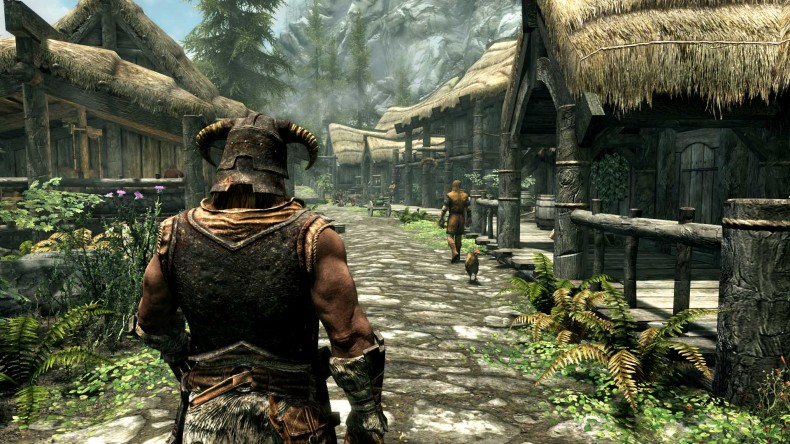If fantasy fiction has taught us anything over the last sixty or so years, it’s that dragons, in all their forms, are cool. Swamp Dragons, Grand Dragons, Gaping Dragons… You’ll be hard pushed to find one that isn’t somehow impressive, whether that’s because of their size and power, their undeniable grandeur, or the fact that they’re voiced by Sean Connery and Benedict Cumberbatch. They’ve been a part of the Elder Scrolls mythos since the beginning, but have only featured in the background lore or, in the case of The Elder Scrolls IV: Oblivion, as the physical manifestation of the God, Akatosh.
Given the huge popularity of the mythical species in games and film, it was a no-brainer for Bethesda to follow the trend and join the likes of BioWare and Blizzard in bringing the fire-breathing lizards into their franchise in a big way. The Elder Scrolls V: Skyrim is as dependant on dragons as it is upon realistic weather effects, with the return of the sky-borne brutes forming the backbone of the main arc. The dragons of Skyrim are majestic and, initially, terrifying, and it’s only after 15 or so hours that you realise they’re not nearly as menacing as they look and you start actively hunting them down when you see them.
But despite the inclusion of dragons and snow and Max Von Sydow, Skyrim was almost its own worst enemy, the sheer scale of the world and depth of detail threatening to shake apart its foundations as a swarm of bugs and glitches plagued the console releases, even going so far as to render the PS3 version nigh unplayable for several months after launch. Although it’s not really a valid excuse, you can certainly sympathise that the rod upon Bethesda’s back was sculpted by their own hands when they poured so much content into Skyrim’s world.
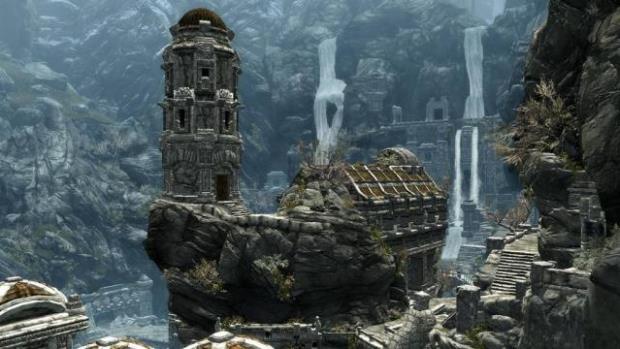
THE CHAOS ENGINE: In fact, one of the biggest improvements made to Skyrim over its Bethesda-developed stable-mates (Oblivion and Fallout 3) was the brand new Creation engine. The step up in graphical fidelity from The Elder Scrolls IV was immense, the art style leaning more towards the ruddy grittiness of, say, Dragon Age: Origins than the Lord of the Rings-inspired whimsy seen in Oblivion. Skyrim’s illusion of life is, on the surface, impressive. Townsfolk walk to and fro both inside and outside of settlements; they do jobs, interact with one another and can live or die according to circumstances such as, for instance, dragon attacks or careless heroes swinging four-foot Daedric Greatswords around in the town-square. Upon closer scrutiny, problems abound, but a player who’s willing to invest in the game rather than pick apart its faults will find a seamless fantasy world quite unlike any other in its breadth of scope and ambition.
Saved from an appointment with an executioner’s block, your character is given the run of Skyrim from the outset, able to travel where you wish and get into literally hundreds of mini adventures on your quest to assume your destiny as the Dovahkiin (or “Dragonborn”) – a mortal warrior fated to destroy the dragons of Tamriel by slaying them and absorbing their souls.
The Creation engine makes the whole journey epic and awe-inspiring, responsible as it is for some of the most jaw-dropping scenery you’ll see on this generation of consoles. From deep, shadow-haunted caverns to snow-shrouded cliffsides traversed beneath the haunting glow of the aurora borealis (or Tamriel’s version of); from tight-packed trees teeming with deer and wolf and goblin to crumbling, disintegrating glaciers that form bridges of floating ice between migrating mini islands – Skyrim’s world is vast and diverse. Climbing to the top of the Throat of the World and looking down upon the distant city you set out from half an hour ago is an incredible feeling, and though time is compressed, the sense of grandeur is not. In Skyrim, you can face trolls in the snow or battle dragons atop distant mountain spires as milky clouds of snow swirl around you – it’s fantasy on a truly epic scale.
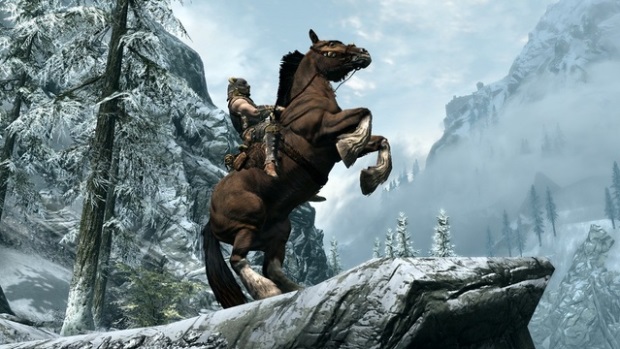
I USED TO BE AN ADVENTURER LIKE YOU: Skyrim’s central story is told not through cutscenes, but through interaction with NPCs and various tomes and scrolls scattered throughout the world. The main quest clocks in at around twenty-five to thirty hours if you play it from start to finish and complete the minimum number of side quests, but a full investment in the world, the lore and the myriad extra-curricular activities will cost you hundreds of hours. This is not an exaggeration – I know people who have put well over 200 hours into a single playthrough, and that’s before you take into account the different races and class builds with which you may want to experiment or even play through the game a second time.
Questing is the meat and potatoes of Skyrim, following the instructions of NPCs and investigating mysteries you stumble upon out in the world. Although the vast majority are not randomly generated, the sheer number of missions you can come across just by talking to the right NPCs is staggering – not to mention the faction-specific quest-lines given for joining up with the Thieves Guild, the Dark Brotherhood, the Companions (a Fighter’s Guild, by any other name), and the magic-centric College of Winterhold. Completing these extra quest-lines is entirely optional, but hugely rewarding to those who take the time. Hell, you might ignore the crisis gripping the province and simply roam the wilds raiding crypts and mines for precious ore and loot – Skyrim offers a level of freedom you don’t often get in an Action RPG.
The class system is such that you’re able to alter your profession on the fly. You’re never locked into one specific class, and you can create anything from a bare-chested brute with a hammer like an anvil to a sneaky thief who relies on marksmanship and alchemical concoctions to achieve his goals. The ten playable races are all humanoid (handily side-stepping any wardrobe problems that might arise), but each has its own racial strengths and weaknesses to add variety and colour to each experience. If there’s a fault with the Class System, it’s that certain skills, like Blacksmithing, are easier to increase than others, meaning you can power level to a certain point by learning a particular skill whether you really want it or not. Without such leg-ups, hitting the 80+ level cap can take you hundreds of hours.
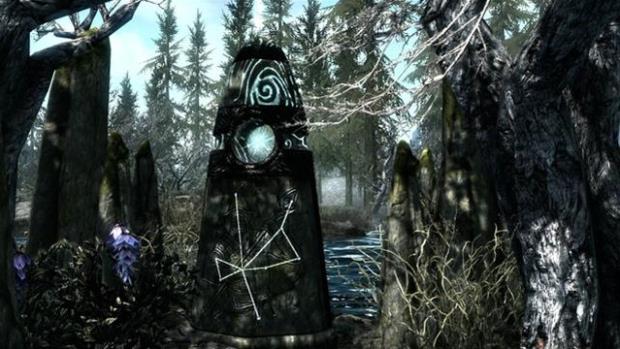
IN FIRE FORGED: If questing and adventuring is the meat and potatoes, then the crafting system is the gravy on top. Although slightly less comprehensive than Oblivion’s, Skyrim’s system allows you to forge and upgrade weapons and armour, imbue items with magical properties and even cobble together jewellery. You can create any piece of standard armour or weaponry you can find in the game, and improve upon it before finding an Enchanter’s table and using your captured souls to add arcane damage or protective properties to it – you can even name everything you create for that extra sprinkling of role-playing goodness.
Although the create-a-spell option from Oblivion is absent, you can still throw together ingredients found in the world and harvested from the dead to concoct potions, poisons and balms to make your adventuring that little bit easier. Some might argue that it’s a superfluous skill and, in all honesty, if you play with the difficulty slider down, you can certainly live without it. However, those looking for a purer and more challenging experience should consider playing with the slider set to the right of the middle and invest some time in Alchemy – the right bundle of potions in your saddlebags can negate the need for learning to pick locks, heal all your ills or even allow you to breathe underwater.
It all adds to the malleable experience that Bethesda really want Skyrim to be – something they largely succeed in creating. The idea being, of course, that you play your own way. You can be good or evil without having to worry about alignment sliders, and enjoy a freeform questing system that doesn’t branch explicitly, but instead changes direction at key points based on certain decisions you make in the narrative. When combined with the mass of optional quest-lines, the system allows Skyrim to adapt itself to suit your style.
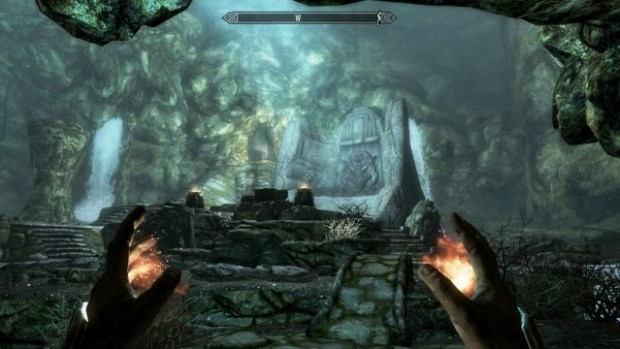
SWORD & NORD: Another element that opens itself up to individual styles is the combat system. You character’s left and right hands can be used together or individually, providing a ton of optional weapon and spell combinations. You may opt to wield two swords or two spells, or go for the more traditional sword & board option; you may carry an axe in your right hand and a fireball spell in your left, or put the same spell in both hands to double its potency; you may even feel that your meat-hooks are better served wrapped around the haft of a sixty-pound battleaxe or twanging the string of a longbow. The quick-change menu seems a little fiddly at first, but it’s not long before you get a handle on what’s sitting where and you’re switching between styles on the fly.
Each method of death-dealing has its pros and cons, and if you have a preferred style when playing RPGs it’s likely you’ll be able to transport it over into Skyrim easily enough. For me, it’s knifing from the shadows and sniping from a distance – preferably with something dipped in poison – and Skyrim caters to the stealthy as evenly as it caters to the loud and brash pugilists among you.
That said, the combat itself isn’t perfect. Switching to a third person viewpoint is still a little floaty, blows don’t connect as they should and it can be almost impossible to hit anything with an arrow or a fireball. In first person, however, Skyrim’s combat is much more tactile. Blocking, parrying and performing execution-style kills becomes more intuitive, less encumbered by uncomfortable controls and ice-skatey movements. More variety in enemy tactics would have been welcome, but it’s still a satisfying – if flawed – combat mechanic.
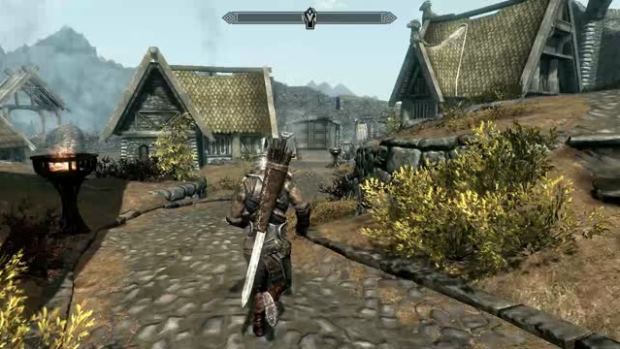
THE JOURNEY OF A THOUSAND LEAGUES: Skyrim is one of those rare games that not only deserves to be played, but deserves to be replayed. I say “rare” because it’s one thing to bash through an 8-hour shooter two or three times, or even a 15-hour dungeon crawl like Diablo III, but it’s something quite different to watch the credits roll on a 100+ hour game, and realise that not only is there still more to do in this playthrough, but that you really want to play it again, differently, and see how much changes.
Console players (particularly PlayStation 3 owners) may never be able to forgive Bethesda for the backwards-flying dragons, incomplete quests and corrupted saves that plagued the first six months after launch, but it’s a shame, because Skyrim is one of the truly great fantasy epics of this generation – it’s certainly one of the most playable Action RPGs to be released in the last decade. While the PC community gets lost in some rather exceptional mods (and Skyrim boasts some of the most impressive examples of community-developed content), the console crowd can extend their time in the frozen North with three chunks of DLC involving vampires, werewolves, a resurrected, rogue Dovahkiin, and the property ladder (the Hearthfire DLC is all about building your dream lodge deep in the woods).
But where next for the franchise? While I wouldn’t confidently rule out an Elder Scrolls VI on next gen consoles, the series is first going MMO with The Elder Scrolls Online, a decidedly World of Warcraft-like massively multiplayer RPG that has split opinion since its announcement. Having had a dabble myself last month I can safely say that it seems to have transitioned well – but my time was short and there’s a way to go until release. For the time being, it’s well worth pulling on your woollens, sharpening your axe, dusting off your oversized horned helm and heading back to Skyrim for one of the biggest, boldest adventures you’ll find this side of the next generation.


